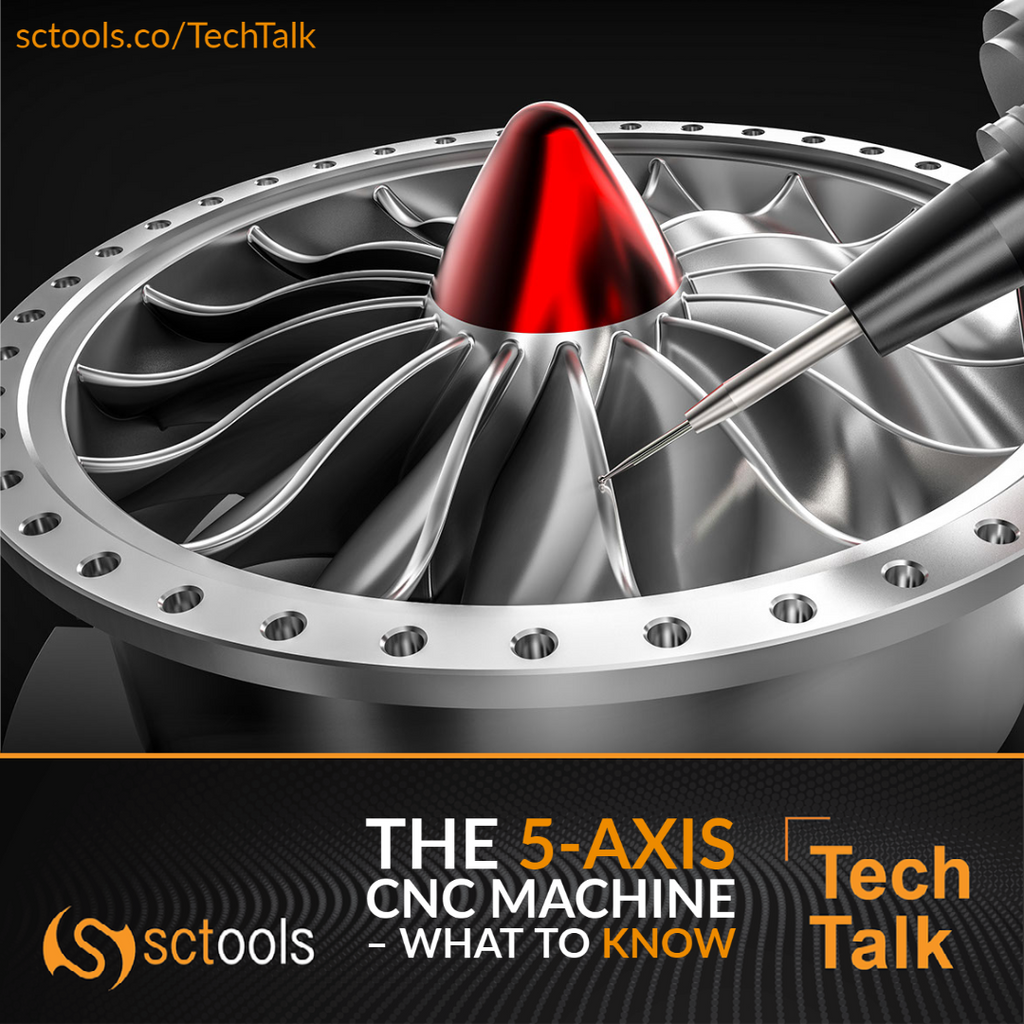.
TechTalk
"The ability to learn is the most important quality a leader can have." - Sheryl Sandberg
The 5 Axis CNC Machine – What To Know
What Is a 5-Axis CNC Machine?
A 5-axis is a machine that can move a tool or attachment around five unique axes simultaneously. While basic or less sophisticated machines operate around three primary axes, X, Y, and Z, the 5-axis CNC provides two more axes in its multidirectional approach. The two additional axes are referred to as A and B.
The axes on the 5-axis CNC machine include three linear axes in addition to two rotational axes. All five directional axes work simultaneously to provide the support needed to achieve complex surface machining. A machine with more directional capabilities, such as the 5-axis CNC machine, helps accomplish complex geometries while working with tighter allowances.
The Benefits of a 5-Axis CNC Machine
5-axis machining allows for more cost-effective and complex manufacturing, especially for more sophisticated designs. Overall, the 5-axis machine reduces cycles times and material wastage while increasing efficiency. Here are some of the top benefits associated with 5-axis machining.
Faster Removal of Materials
The 5-axis CNC machine consistently works from start to finish. What this means is that every time the cutting tool passes, it removes more material. The consistent removal of material is possible because, during 5-axis machining, the cutting tool remains peripheral to the material's surface the entire time. By constantly removing more material as the 5-axis machine continues to cut, users can cut back on cycle times, helping to save costs and time spent working on a single project.
Rotational Accuracy
Anytime you add planes or axes to a machine's functionality, you improve the machine's overall accuracy. With enhanced precision, the 5-axis CNC machine can achieve a superior quality regarding the finished product. Compared to a typical 3-axis machine, the additional two axes found on the 5-axis allow users to complete a task in just one setup. Creating multiple complex shapes without losing any precision and quality is a significant differentiator between the 5-axis machine and those with fewer axes.
Added Complexity To Designs
In addition to the rotational accuracy, the 5-axis machine allows users to achieve even more complex designs and shapes through different movements. 5-axis machining gives you access to angles, arcs, and features that were not previously achievable in a single setup. Before the 5-axis machine, using multiple arcs and angles could only be accomplished by setting up the machine numerous times with several unique features and fixtures. Ultimately, the 5-axis machine makes it easy to achieve the desired geometry in a single process through machining that eliminates the need for multiple setups and fixtures.
Improved Surface Finishes
The additional axes included in the 5-axis machine, referred to as A and B, help the user position and bring the material closer to the cutting tool. Because the 5-axis machine allows the user to set their material closer to the cutting tool, this tool is shorter than the one used on a 3-axis machine, helping to decrease the amount of vibration delivered at extremely high-speed cutting. Reducing the vibrations by using a more straightforward tool provides a better surface finish. To achieve a similar level of surface quality with a 3-axis machine, an operator must use much more minor cuts, resulting in longer lead times and less efficiency.

Looking Towards The Future: The 6-Axis CNC Machine
6-axis machining improves even further on the 5-axis CNC machine. By reducing cycle and lead times, manufacturers and operators can forward to even greater production and improved efficiency. CNC machines operate by cutting away and shaving off sections of raw material to achieve a desired design, shape, and finish.
The 6-axis CNC machine uses a finished product without any defects by utilizing six individual axes that operate from both sides of the fixture. This innovative machine was conceived with volume machining in mind. Processing steel, aluminum, cast irons, and other model-making materials can be achieved incredibly quickly and with superior quality regarding the finished result. Currently, these machines are used in high-volume operations for productions that require impeccable accuracy, such as automotive and aerospace parts.
The Wrap Up
Turning raw materials into finished products requires efficiency, accuracy, and incredible quality. CNC machines with a significant number of axes improve nearly every aspect of processing, including accuracy, quality, efficiency, lead time, and surfacing. The higher volume experience by a manufacturer, the higher number of axes their CNC machine should provide.
Though 5-axis machining currently offers an acceptable quality, efficiency, and accuracy, 6-axis machining provides a bright and exciting future for raw material finishing. Companies processing significant amounts of raw materials will quickly accomplish their goals with an unmatched, high-volume cutting machine like the 6-axis CNC machine.
 If you have any questions about carbide cutting tools, be sure to reach out to us @ sctools.co/Home or call us at (877)737-0987.
If you have any questions about carbide cutting tools, be sure to reach out to us @ sctools.co/Home or call us at (877)737-0987.

Comments (0)